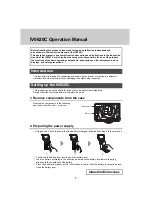
XT2640 Operating Manual
13 July 2016
Page 37 of 187
then any amplitude measurements in progress are terminated and new measurements are started using this new
frequency.
If NORMAL is selected then the XT2640 measures the fundamental frequency using a measurement period optimized for
both speed and resolution. Changes in the fundamental frequency are not applied until the next amplitude measurement is
started.
If SLOW is selected then the XT2640 measures the fundamental frequency using a long measurement period which has the
best resolution. Changes in the fundamental frequency are not applied until the next amplitude measurement is started.
Note:
When configured for EN61000‐3‐2 or ‐12 measurements this preference setting is ignored.
Recommendations:
For most applications the NORMAL setting should be used.
For applications where it is desirable to track changes in the fundamental frequency as closely as possible (e.g. a variable
speed motor) or when using the XT2640 at frequencies below 1Hz then the FAST setting should be considered.
For applications where the fundamental frequency is considerably affected by modulation or other effects then the SLOW
setting should be considered.
12.3.1.6
SELECTING
A
PHASE
PREFERENCE
The PHASE button allows you to select how phase information is displayed and returned via an interface. The XT2640 supports
several methods of showing phase results as selected by this preference setting which affects all phase results.
If
Math,+/
‐
180°,CW
is selected then the XT2640 returns all phase results as mathematical phases in the range from ‐180°
to +180° and the chart on the VECTORS screen (see 12.8) is displayed with increasing phase as a clockwise rotation of the
chart.
If
Math,+/
‐
180°,CCW
is selected then the XT2640 returns all phase results as mathematical phases in the range from ‐180°
to +180° and the chart on the VECTORS screen (see 12.8) is displayed with increasing phase as a counter‐clockwise
rotation of the chart.
If
Math,360°,CW
is selected then the XT2640 returns all phase results as mathematical phases in the range from 0° to 360°
(no polarity is displayed) and the chart on the VECTORS screen (see 12.8) is displayed with increasing phase as a clockwise
rotation of the chart.
If
Math,
360°,CCW
is selected then the XT2640 returns all phase results as mathematical phases in the range from 0° to
360° (no polarity is displayed) and the chart on the VECTORS screen (see 12.8) is displayed with increasing phase as a
counter‐clockwise rotation of the chart.
If
Delay,+/
‐
180°,CW
is selected then the XT2640 returns all phase results as phase delays in the range from ‐180° to +180°
and the chart on the VECTORS screen (see 12.8) is displayed with increasing phase as a clockwise rotation of the chart.
If
Delay,+/
‐
180°,CCW
is selected then the XT2640 returns all phase results as phase delays in the range from ‐180° to
+180° and the chart on the VECTORS screen (see 12.8) is displayed with increasing phase as a counter‐clockwise rotation
of the chart.
If
Delay,360°,CW
is selected then the XT2640 returns all phase results as phase delays in the range from 0° to 360° (no
polarity is displayed) and the chart on the VECTORS screen (see 12.8) is displayed with increasing phase as a clockwise
rotation of the chart.
If
Delay,
360°,CCW
is selected then the XT2640 returns all phase results as phase delays in the range from 0° to 360° (no
polarity is displayed) and the chart on the VECTORS screen (see 12.8) is displayed with increasing phase as a counter‐
clockwise rotation of the chart.
Note:
If a Math preference for phase is selected then if a phase of ø is shown then mathematically the signal is S.sin(ωt + ø).
If a Delay preference for phase is selected then if a phase of ø is shown then mathematically the signal is S.sin(ωt ‐ ø).
The selection of the numeric range for phase results does not affect the results themselves. Phase results in the range 0° to
+180° are unaffected; results in the range +180 to +360° (for a 0 to 360° selection) are exactly equivalent to the range ‐180
to 0° resp. (for a +/‐180° selection) and vice versa.
The CW or CCW portion of the selection only affects how the vectors chart is displayed on the VECTORS screen, no other
data or results are affected by this selection.
12.3.2
CONFIGURING
THE
INTERFACE
You may initiate the Interface Configure Screen by either pressing the Interface Info Area while on any main screen, or pressing the
SYS CONFIG button and then pressing the INTERFACE button on that screen.
Note:
Changes to the interfaces can only be made while not in remote.
















































